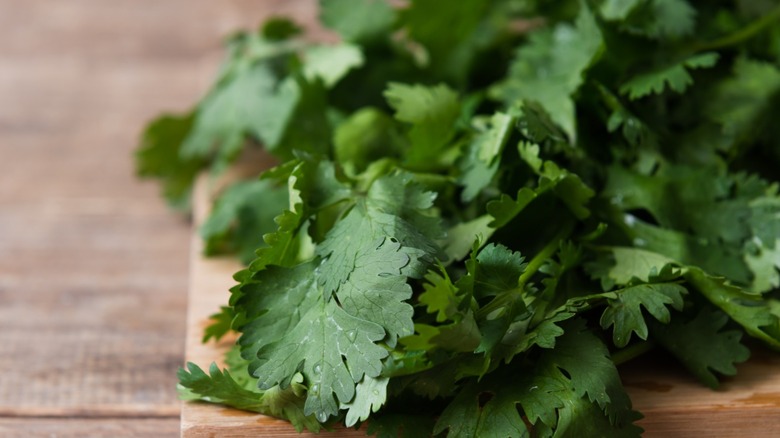Cilantro Vs Culantro: What's The Difference Between The Similarly Named Leafy Herbs?
You've probably heard of cilantro, but "culantro" may look like a typo if you've never used it before. Rest assured, cilantro and culantro are two different herbs, though their similarities do go beyond just names spelled almost exactly alike. Taste-wise, culantro and cilantro both have distinctive flavors of pepper and citrus (though if you, like Julia Child and Ina Garten, think cilantro tastes like soap, that's due to a genetic mutation). In the kitchen, both leafy herbs are used to brighten up other flavors and add finishing touches as garnishes. And, here's where things really get confusing, culantro is also called "long coriander" while cilantro is also called "coriander." Yes, they're even from the same plant family (Apiaceae).
But on to the key differences, which are important to understand if you wish to use them correctly in cooking. Appearance-wise, the two are obviously different plants; cilantro has small, delicate leaves that look similar to parsley, whereas culantro has long, serrated leaves with flower buds that have been compared to the head of a pineapple. And although the two have similar taste profiles, cilantro is more light and citrusy, whereas culantro is more potent and has an almost-musky aroma. It's also worth noting that cilantro is an annual herb, whereas culantro is perennial. While these differences may not sound too drastic, they can dictate how you incorporate culantro and cilantro into your cooking, including how much of each herb to use at a time.
Culinary cues for how to use culantro
If you like cilantro, consider culantro its more robust cousin. Though if you've never heard of it before, perhaps you've heard one of its many other names:saw leaf herb, Mexican coriander, spirit weed, Puerto Rican coriander, black benny, recao, eryngo, or the scientific Eryngium foetidum — and that's just the short list! Even if you're not familiar with culantro, you may have tasted it and mistaken it for extra-strong cilantro. Thriving in warm, wet climates like the Caribbean, Central America, and Southeast Asia, this herb makes frequent appearances in the cuisines of these regions. Culantro is considered an essential ingredient in Cuban cuisine, for example, and a must-have for many traditional dishes. It's also a pivotal ingredient in Puerto Rican sofrito, a seasoning blend of herbs, peppers, and onions.
Never cooked with culantro before? Keep in mind that a little bit goes a long way. Not only is it naturally more potent than its cilantro counterpart, but another thing that really separates culantro as a unique herb is that it tolerates heat well over time. This means its flavor won't diminish much while you're cooking with it, even if you let it simmer for a while a stew or broth. To release more herbaceous notes though, tear or cut the culantro leaves before doing this. You can also chop the herb into a chiffonade to zest up your salads, add as a balancing garnish for spicy foods, or mix it into sauces for deeper, more peppery flavors.
Cooking with cilantro, the versatile herb
Controversy over its soap-like flavor (for some people) aside, cilantro is an incredibly popular herb for a wide range of foods. The herb originally comes from the Mediterranean, but it's become prevalent all over the world, especially Mexican and Asian cuisines. It's also known by its scientific name, Coriandrum sativum, or simply coriander, though this can get a tad confusing as the spice coriander actually comes from the seeds of the same plant. The spice has its own purpose, of course, but the leaves are where it's at if you're looking for bright pops of citrus zest and soft pepper notes. Cilantro's flavor is not as strong as culantro, but it's arguably the more versatile of the two since it's so light and easy to add to just about anything.
Looking for ideas? Add chopped cilantro to rice dishes for a burst of herbal freshness. You can also use it in a spicy curry for a bright, citrusy kick. And while cilantro leaves are commonly used as a garnish for things like tacos and dips, you can make a seriously tasty salsa with a full cilantro plant — just chop up the leaves and stems, and blending it all in with your other ingredients. If you find yourself stocking up frequently on this versatile herb, you can even try growing your own cilantro to always have on hand.


